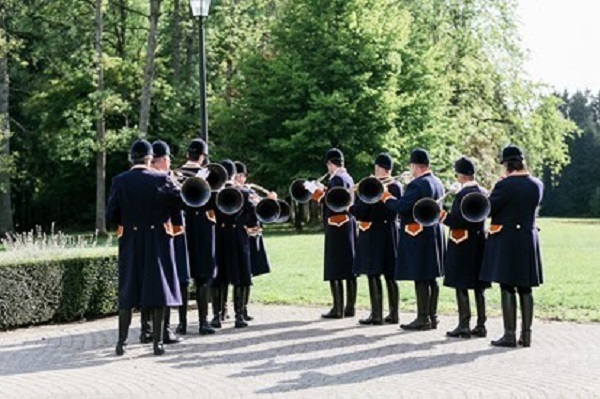 Horn blowers or "Haupeschbléiser" in Luxembourgish;
Credit: MCUT
Horn blowers or "Haupeschbléiser" in Luxembourgish;
Credit: MCUT
Luxembourg's Ministry of Culture and the Luxembourg Commission for Cooperation with UNESCO announced today the inscription of the "musical art of horn players" on the UNESCO Representative List of the Intangible Cultural Heritage of Humanity.
The musical art of horn players emerged in the 18th century at the French Royal Court. Since then, this art has become a living tradition in these regions, as exemplified by the allegorical representation of Luxembourg by Julien Lefèbvre (Hotel Alfa, around 1930, classified as a national monument). Today, in the Grand Duchy, men and women of different nationalities, ages and social backgrounds come together during their free time to keep this cultural heritage alive.
In Luxembourg, these musicians are called "Haupeschbléiser", named after Saint Hubert, their patron saint. Their instrument, said to be “natural” because it has no pistons, is sounded using very physical breathing techniques, preferably in nature, where its archaic timbre can resonate freely. Singing also plays an important role in the transmission of this musical art. Sounding without a score, in frock coats, the musicians turn their backs on the audience to allow them listen to the sound of their horns as well as possible.
Alongside the international classical repertoire, the horn players also sound and compose scores for fanfares dedicated to Luxembourg. They actively participate in the cultural life of the Grand Duchy and are members of the Union Grand-Duc Adolphe (UGDA), as well as of the Fédération des trompes du Bénélux (FTB) and the Fédération internationale des trompes de France (FITF).
The musical art of horn players has been listed in Luxembourg's national inventory of intangible cultural heritage since 28 November 2018. On 29 March 2019, Luxembourg submitted to UNESCO, jointly with France, Belgium and Italy, a multinational application for the inscription of this musical art on the Representative List of the Intangible Cultural Heritage of Humanity.
For Luxembourg, this is the second UNESCO inscription of its living heritage, exactly ten years after the inscription of the dancing procession of Echternach, and the first inscription of an element through a multinational application.








